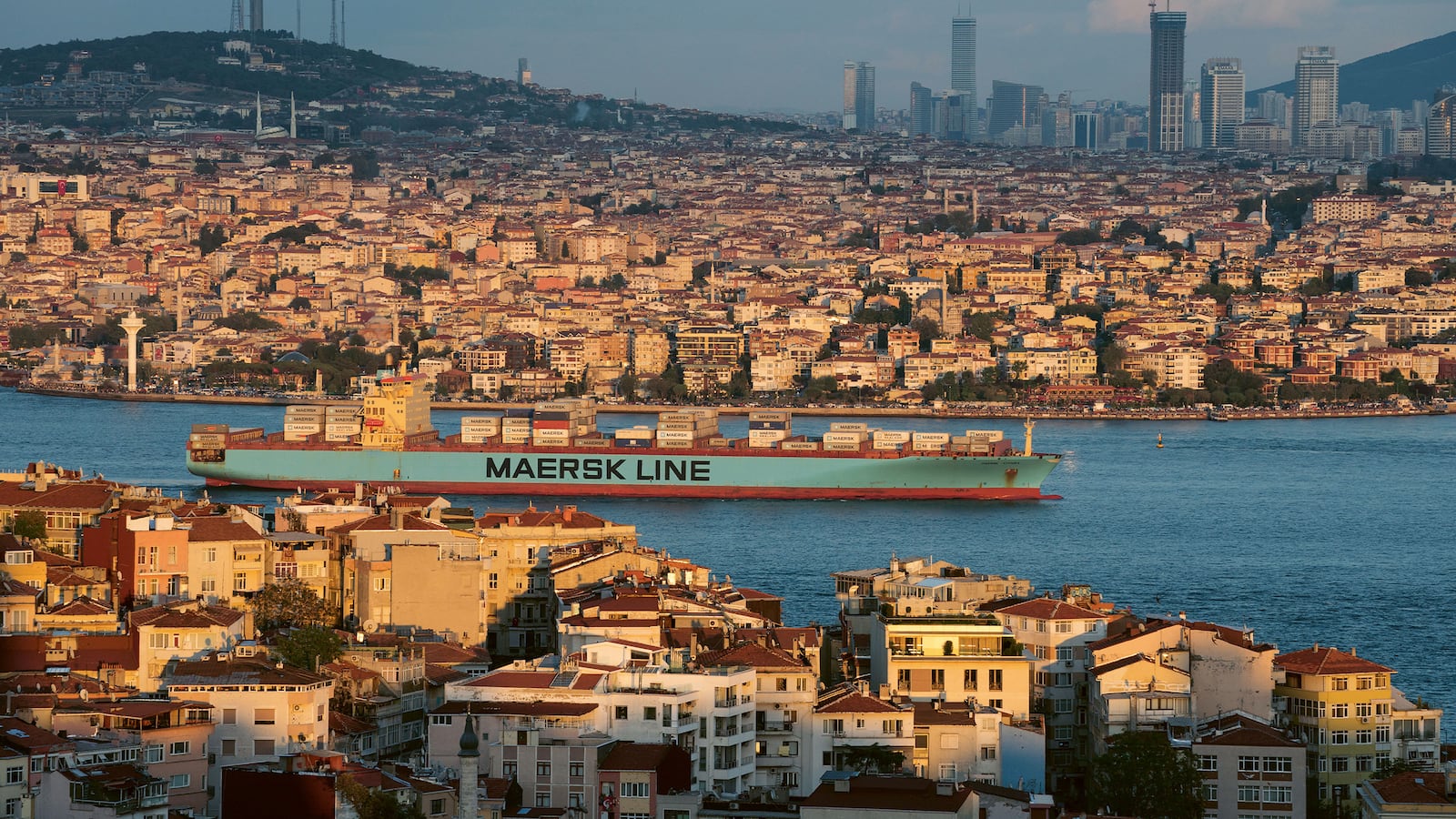“Half the people you meet in Istanbul are from the Black Sea,” said a news bureau chief over meze one night in Istanbul’s vine-tangled Cihangir neighborhood.
And how right he is. Istanbul, straddling both Europe and Asia, is very much a Karadeniz (Black Sea) city, too, connected to it by the throat of the Bosphorus, ever since an earthquake forced a passage from the Mediterranean thousands of years ago.
Today its neighborhoods, spread throughout the Asian and European sides of the city, are a soup of Black Sea families, merchants, general stores, and restaurants. Busy cafés in Beyoğlu, just off of touristy Istiklal Caddesi, such as Klemuri and Hayvore, sell versions of hamsi (anchovy) pilaf, cornbread and buttery chard soups—all quintessentially Black Sea dishes.
The mournful strains of kemençe—a Black Sea violin—can sometimes be heard around the streets of Kadıköy, replacing Turkish pop and Greek Rebetiko, while Black Sea cultural centers provide solace to the homesick in the form of dances, card games, and buffets.
At the break of dawn on Sunday mornings, traders start arriving from Black Sea towns and cities, having driven all night, to sell their jam, molasses, and nuts, at Istanbul’s Kastamonu Market.
For centuries, the Bosphorus carried a constant flow of Black Sea-bound traffic, both day and night. Ottoman explorer and travel writer Evliya Çelebi noted in the 17th century that in Istanbul 8,000 people were engaged in Black Sea trade, providing the city with rice, salt, honey, butter, and leather from the ports of northern Anatolia, Crimea, and Europe.
So while the Sea of Marmara is Istanbul’s closest and most obvious maritime partner, the Black Sea—not just a coastline but a whole region spreading deep into the interior—permeates Istanbul strongly, seeping deeply into the city’s psyche. For visitors, it is easy, with a map and a hit list, to experience a Karadeniz day in Istanbul, starting on the Asian side of the city, in Kadıköy.

Black Sea: Dispatches and Recipes, Through Darkness and Light by Caroline Eden.
Brushing past a waiter, chef Necla Hanim carried a copper pan of muhlama to the table. A trio of cheese, golden cornmeal, and butter, it glistened and wobbled as she walked. “The cheese has a very high fat content. You have to eat it fast or else it sets,” she said, placing it in front of me and offering a welcome challenge.
Çay Tarlasi (literally “Tea Field”) in the neighborhood of Kadıköy, is decked out in the style of traditional wooden log houses found around the northeast tea-growing Black Sea region, by the Georgian border. This was where Necla left, with her husband Oğuz Koyuncu, 20 years ago, to open this café here in Istanbul.
Newspaper clippings from local restaurant critics (all highly praising the muhlama) hang on the walls above encyclopedias about the Black Sea and black-and-white photographs of submarines. Serving the Black Sea diaspora who want to be reminded of home, local students, and Istanbullus who appreciate Necla’s cooking, the little café is busy, buzzy, and well used.
The stringy cheese twisted around my fork, glistening like stretchy spaghetti, but just as I was about to take a bite, my forkful was interrupted by an intense-looking mustachioed man sitting at an opposite table, who had been listening to our conversation.
“The best ingredients are in there. The best. Trabzon butter, cheese, and cornmeal. The best!” he said, pointing at the muhlama with his umbrella, a tulip-shaped glass of tea in his other hand.
I nodded. Then, finally, with the mustachioed man still watching me (was he the chef’s father? A loyal customer? A proud citizen of Trabzon?) I tasted it. The soft, buttery, and salty flavors of the koloti cheese, also the secret ingredient in Çay Tarlasi’s menemen breakfast, meshed with the rich butter and cornmeal. It was similar to fondue, but so much better than that.
I smiled and the mustachioed man smiled back and, satisfied, returned to his newspaper.
“Muhlama is a poor man’s dish back at home, but there we walk it off in the hills. Here, it is a luxurious treat because we don’t,” Necla said, folding a napkin. She explained that she has Hemʂin (Armenian) heritage, while Oğuz is Laz (ethnic Georgian), both groups found in the far east of Turkey’s Black Sea region and in large cities such as Istanbul. The television behind her flickered with images of the war in Syria. Grimacing, she grabbed the remote and turned it off.

Oğuz, dressed in a lumberjack shirt, hair tied back in a ponytail, heaved his large frame over. “I’m sorry, I didn’t want to shake your hand before because I was eating, not because you’re a woman,” he belly laughed as he said this, acknowledging the absurdity. But there are growing divisions in Istanbul, and people’s guards are uncharacteristically up.
“You must try our Laz börek. Even if you have had it before, it was not real Laz börek. We don’t put syrup on ours,” Oğuz said, disappearing into the kitchen.
The Laz are often the butt of jokes in Turkey, drawn as birdbrained highlanders, as the writer Sevan Nisanyan explains in his book on the Black Sea: “He sports a majestic nose and speaks Turkish with an outrageous accent. His diet consists of hamsi (Black Sea anchovies), cooked to the legendary one hundred recipes that include hamsi bread and hamsi jam ... Inevitably the most brilliant Laz jokes are circulated by the Laz themselves.” It's also said that the Laz are fiercely hospitable, and fiery too, choosing, when necessary, to “talk with the pistol.”
I wonder if anyone would be brave enough to insult Oğuz who, despite his gentle demeanor, is built like a grizzly bear. Like the muhlama, the Laz börek announces itself with an explicit threat to the waistline. It is hedonistic, heavy, and irresistible, allowing no possibility whatsoever for seconds. It is different from typical börek because Laz börek is sweet, not savory. If you imagine a slice of baklava with paper-thin filo, but the size of a deck of cards and crammed with custard instead of nuts, you’re somewhere close.
Çay Tarlasi is a classic Istanbul café in that it serves only a handful of dishes and it serves them very well to its loyal, local clientele. Its selling points are simple: time-honored recipes, good ingredients, and family connections. As I leave, my Turkish-speaking friend, Ugur, tells me that Oğuz is the brother of a very famous Laz singer, Kazim Koyuncu, who died tragically young. They look similar, Ugur tells me. Long hair, beards, open faces. I later read that Kazim was an environmental campaigner with concerns about the Black Sea, that he was a singer in a band called The Children of the Sea, and that his solo albums were smash hits.
A ten-minute walk away from Çay Tarlasi is Kadıköy Pazarı, the local bazaar containing a warren of specialist food traders that form a ground zero, of sorts, for lovers of Turkish produce. Glass dispensers of purpley-brown pekmez (grape molasses) stand next to piles of pestil (fruit leather), canisters of nuts, and ginormous plastic tubs of turʂu (pickles).
In the middle of it all, on Güneʂli Bahçe Sokak, is the tiny Eta Bal honey shop run by Ahmet Aksoy from the Black Sea tea-centric city of Rize. Reaching over jars of bee milk, pollen, and honeycombs, he first hands me his business card, to prove to me that he is, as he claims to be, “a bee products expert,” then dabs different, sticky-sweet honeys onto little wooden strips for tasting. I licked the sticks and squeezed into a corner, making myself as small as possible, to make way for the almost constant stream of customers who pile into his tiny shop to buy his first-rate honeys.
The flavors toggle between chestnutty and floral, but it is the Karakovan Balı—black hive honey produced by bees in the wild—that is in a league of its own. Subtle oregano mixes with lavender notes, although it is pretty much indescribable, as it is like no other honey. Honey, like wine, is dependent on its terroir, and the green hills of the Black Sea provide beekeepers with high mountain pastures, called yaylas, fresh meadows, and clean air. Aksoy’s honeys are about as far as you can get from the unholy, mass-produced honey found on supermarket shelves back home.
Staying on the Asian side of the city, heading five miles north in the direction of the Black Sea, a smoky taxi ride takes me to Trabzon Kültür Derneği (Trabzon Cultural Association) in residential Üsküdar. Ugur, immediately recognizing the driver’s Black Sea accent, asks him where he’s from. “Rize,” the man replies. We both raise our eyebrows and shrug our shoulders at the coincidence.
Excerpted with permission from Black Sea: Dispatches and Recipes by Caroline Eden, published by Quadrille May 2019, RRP $35 hardcover—winner of the 2019 Edward Stanford Travel Writing Awards “Travel Food and Drink Book of the Year” and the 2018 André Simon Awards “John Avery Award.”






